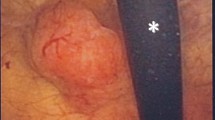Abstract
Background and objectives:Lymphoepithelioma-like carcinoma (LELC) is anundifferentiated epithelial tumor with a denseinflammatory infiltrate that resembles thelymphoepithelioma of the nasopharinx occurringin other sites. Primary LELC of the bladder(LELCB) was first reported by Zukerberg et alin 1991. The incidence of LELCB is 0.4%–1.3% of all bladder carcinomas. The mean ageat diagnosis is 69 years. Of the patientpopulation 69% are men. Herein we report onone more case of primary predominant LELCB andreview all the English literature concerningthis subject after performing a pooled analysisof the cases recorded in the Eglish literatureincluding the present one.Materials and methods: The reports of 43patients including the present case of primaryLELCB from the English literature werecollected from 1991 to 2002. Patients wereevaluated for age, sex, primary and adjuvanttreatments, clinical staging, follow-up andoutcome, and disease related survival. Theoverall patient population was separated into 3groups according to the LELCB classification ofAmin. Results: The overall patientpopulation included 31 males and 12 females.Average age was 68.4 years (range 52–84). LELCBhistological subtypes resulted pure in 17cases(40%), predominant in 16 (37%) and focal in10 (23%). Mean follow-up was 37.7 months(range 0–216). Outcome resulted as follows: 26patients (62%) did not show evidence ofdiasease (62%), 11 (26%) died of disease, 1(2%) was alive with metastases, and 4 (10%)died for causes unrelated to the primarydisease. Survival rate related to specificdisease resulted 71%. Mean follow-up was 48.1in the first group (pure LELCB), 32 in thesecond (predominant LELCB), and 30.3 in thethird one (focal LELCB). Patients with notevidence of disease were 13 (81%) in group 1,13 (82%) in group 2, and 0 in group 3.Patients who died of their disease resulted 1(6%) in the first group, 1 (6%) in thesecond, and 9 (90%) in the third one. Patientswho died for disease not related to the primarytumor were 2 (13%) in the first group, 1 (6%)in the second, and 1 (10%) in the third one.One patient (6%) was alive with metastases ingroup 2. Survival rate related to specificdisease resulted 93% in the first group, 93%in the second one, and 0% in the third one.Conclusions:To date, there are no clear guide lines for the treatment of LELCB. Treatments performedinclude both deep transurethral resection ofthe tumor (TUR-B) as well as partial or radicalcystectomy, with or without adjuvant treatmentsincluding systemic chemotherapy andradiotherapy. The prognosis is favorable forpatients presenting with the pure andpredominant forms with a diploid DNA patternand very poor for patients presenting withfocal LELCB. Bladder salvage therapy byperforming both TUR-B alone or combined withadjuvant systemic chemotherapy may be areasonable option for patients with pure orpredominant LELCB, while radical surgery withadjuvant systemic therapy may be indicated forfocal muscle invasive LELCB.
Similar content being viewed by others
References
Young RH, Eble JN. Unusual forms of carcinoma of the urinary bladder. Hum Pathol 1991; 22: 948–965.
Eble JN, Young RH. Carcinoma of the urinary bladder: a review of its diverse morphology. Seminars in Diagnostic Pathology 1997; 14: 98–108.
Fukunaga M, Ushigome S. Lymphopeithelioma like carcinoma of the renal pelvis: a case report with immunohistochemical analysis and in situ hybridization for the Epstein-Barr viral genome. Mod Pathol 1998; 11: 1252–1256.
Zukerberg LR, Harris NL, Young RH. Carcinomas of the urinary bladder simulating malignant lymphoma. Am J Surg Pathol 1991; 15: 569–576.
Dinney CPN, Ro JY, Babaian RJ, Johnson DE.Lymphoepitelioma of the bladder: a clinicopathological study of 3 cases. J Urol 1993;149:840–842.
Young RH, Eble JN. Lymphoepithelioma-like carcinoma of the urinary bladder. J Urol Pathol 1993; 1: 63–67.
Amin MB, Ro JY, Lee KM et al. Lymphopeithelioma-like carcinoma of the urinary bladder. Am J Surg Pathol, 1994; 18: 466–473.
Bianchini E, Lisato L, Rimondi AP, Pegoraro V. Lymphoepithelioma-like carcinoma of the urinary bladder. J Urol Path 1996; 5: 45–49.
Holmang S, Borghede G, Johansson S. Bladder carcinoma with lymphoepithelioma like differentiation: a report of 9 cases. J Urol 1998; 159: 779–782.
Costantinides C, Giannopoulos A, Kyriakou G et al. Lymphoepithelioma-like carcinoma of the bladder. BJU 2001; 87: 121–122.
Lopez-Beltran A, Luque RJ, Vicioso L et al. Lymphoepithelioma-like carcinoma of the urinary bladder: a clinicopathologic study of 13 cases. Virchows Arch 2001; 438: 552–557.
Gulley ML, Amin MB, Nicholls JM et al. Epstein-Barr Virus is detected in undifferentiared nasopharygeal carcinoma but not in lymphoepitelioma-like carcinoma of the urinary bladder. Hum Pathol 1995; 26: 1207–1214.
Iezzoni JC, Gaffey M, Weiss LM. The role of Epstein-Barr virus in lymphoepithelioma like carcinomas. AMJ Clin Pathol 1995; 103: 308–315.
Author information
Authors and Affiliations
Corresponding author
Rights and permissions
About this article
Cite this article
Porcaro, A.B., Gilioli, E., Migliorini, F. et al. Primary lymphoepithelioma-like carcinoma of the urinary bladder: Report of one case with review and update of the literature after a pooled analysis of 43 patients. Int Urol Nephrol 35, 99–106 (2003). https://doi.org/10.1023/A:1025981106561
Issue Date:
DOI: https://doi.org/10.1023/A:1025981106561




